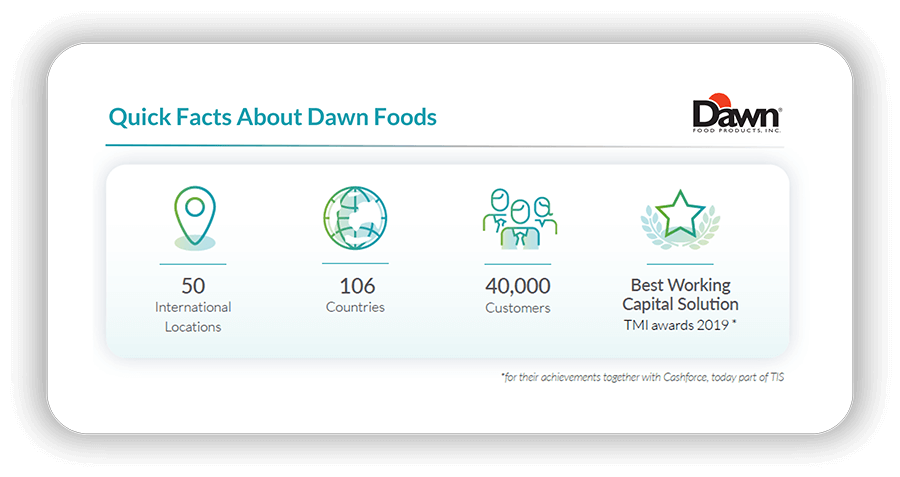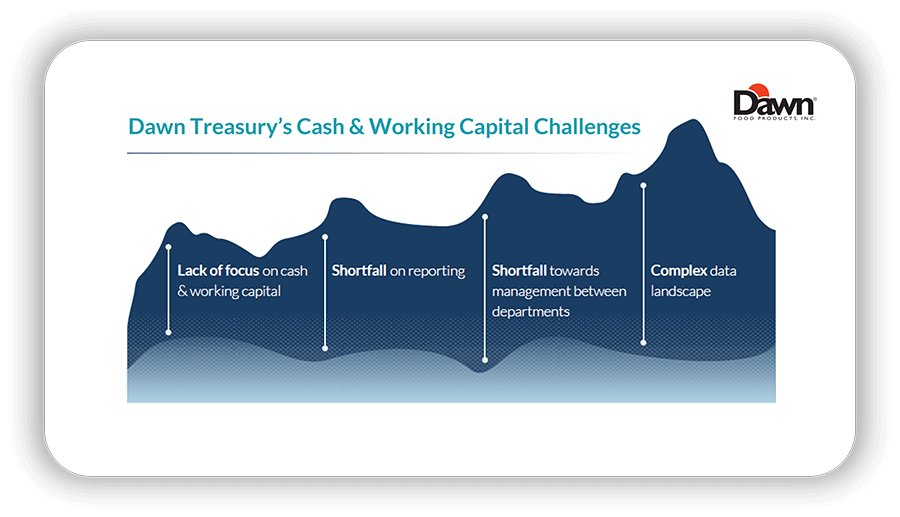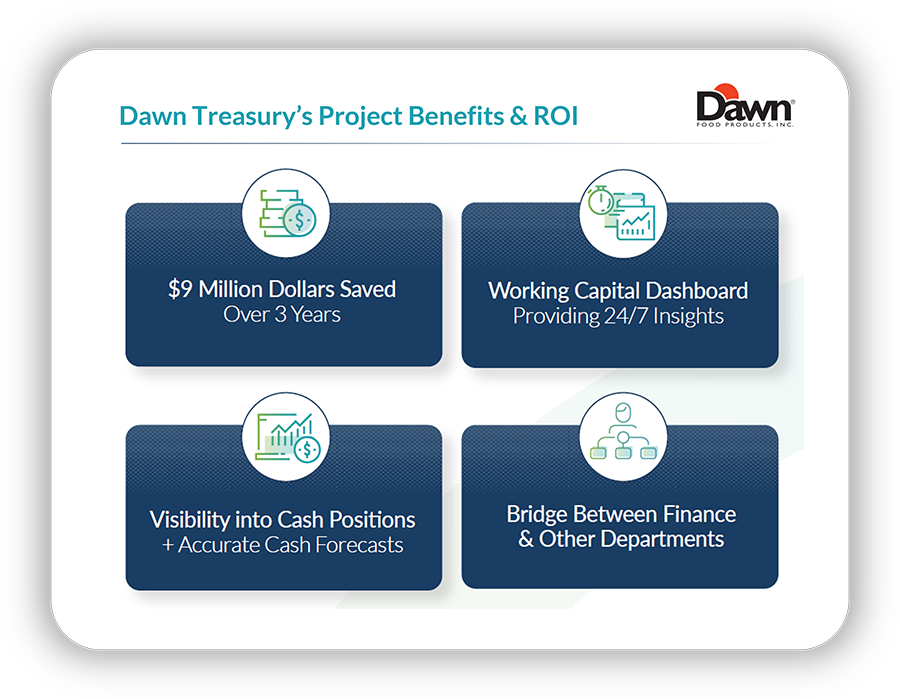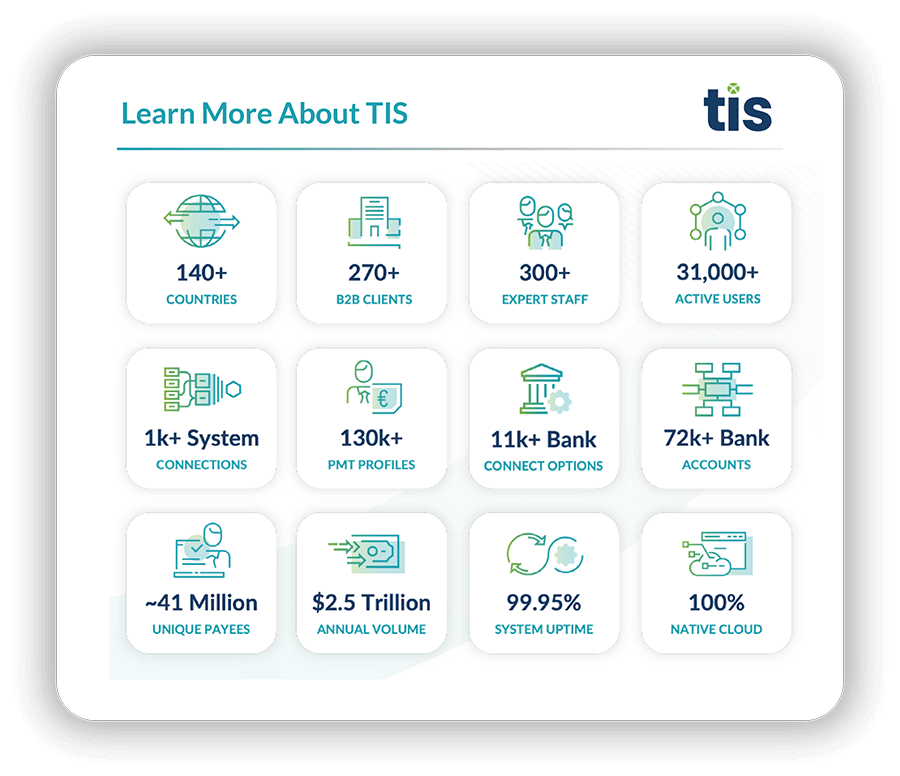About Dawn Foods
Dawn Foods is a global B2B bakery ingredient supplier with multiple entities and finance departments worldwide. With more than $1.3 billion in annual revenue, 5,000+ employees, 50 global locations, products in 100+ countries, and 40,000+ B2B clients, they are a central player in the food industry. Dawn Foods started in 1920 with a vision to provide bakers with high-quality, great-tasting ingredients. Today, they continue pushing towards that vision by inspiring bakery success every day. As a family owned, global bakery leader, Dawn Foods inspires to transform the industry and promote their customers’ success by having the best people in the business, industry-leading products, and meaningful partnerships with their customers, partners, and clients.
Dawn Foods At-A-Glance
- $1.3 Billion Annual Revenue (2022)
- 5,000+ Employees Across 50 Locations Globally
- Products in 100+ Countries With 40,000+ B2B Customers
- Over 100 Years in Business

Understanding Dawn’s Cash Management & Working Capital Conundrum
Over the past several decades, Dawn Foods has continued to expand their business through a combination of organic growth and numerous mergers and acquisitions. As a result, their operations came to consist of multiple sub-entities located around the world, many of which continued to rely on their own sets of back-office systems and underlying financial workflows. For the Dawn Foods treasury group, this largely decentralized expansion resulted in numerous complexities over time – particularly with regards to managing cash, maintaining visibility to liquidity and payments, and effectively forecasting cash flows. In addition, treasury experienced challenges with controlling AP / AR workflows across their various entities and were strained to monitor and optimize working capital positions. Vendor payment and invoicing behaviors were difficult to track and monitor as well.
Eventually, the pain points associated with their disparate financial landscape became too much. So starting in 2015, the finance and treasury group at Dawn foods kicked off a multi-year, multi-phase change management process with the goal of turning their organization into a more cash-oriented company. The key objective was a 10% year-over-year reduction of Net Working Capital Days, along with a heightened emphasis on the ability to effectively forecast global cash flows.
At the time of their project kick-off, Dawn was operating without a dedicated treasury management system or multi-banking solution, which meant that cash positions were manually created and based on a combination of spreadsheets, banking portals, and other sources. At the same time, many local entities were continuing to operate with their own set of banking relationships and underlying accounts, which further complicated the process of managing global cash. As a result, the effort to generate cash positions often lasted several days and required input from numerous stakeholders and departments – including those operating at different entities and offices worldwide.
In order to correct these inefficiencies, Bart Messing, European Treasurer at Dawn Foods, was tasked with orchestrating the global rollout of their change management project. In Q2 of 2015 and in close cooperation with his peers across the finance team, he began to plan out the desired changes.
Dawn’s Cash Management & Forecasting Project: Goals & Requirements
During the initial stages of Dawn’s working capital and cash forecasting project, the main objectives were as follows:
- centralizing cash visibility for treasury and finance colleagues at the HQ level,
- consolidating disparate bank relationships and account structures,
- implementing a cash pooling structure to more easily distribute and manage liquidity,
- developing shared cash and working capital KPIs to drive collaborative improvements,
- upgrading and simplifying their global technology architecture for streamlined operations, and
- deploying a refined cash flow forecasting and working capital analytics process to more accurately predict future cash positions and optimize DSO, DPO, and DIO metrics.
In order to unite the organization in pursuit of these goals, Dawn’s project focused firstly on collaborating and aligning internally on what the most critical cash and working capital KPIs were for each department and business unit. This alignment was followed closely by a renewed emphasis on technology unification and simplification across Dawn’s back-office and banking structure. And finally, a series of new processes were expected to be deployed within all entities and departments to ensure a globally cohesive approach to managing cash, liquidity, and working capital.

Over the next few years from 2016-2019, Bart Messing and his treasury and finance peers worked cross-collaboratively with AP, AR, IT, and a myriad of bank partners and vendors to introduce a new set of workflows, technologies, and financial KPIs. They also launched an RFP to identify the best-fit solution provider for upgrading their cash flow forecasting and working capital processes. By 2019, these efforts had resulted in a widespread reduction of banks and accounts used, as well as a significant increase in daily cash visibility. And with their new working capital solution from TIS, combined with improved internal measures to educate and inform their personnel, Dawn saved nearly $10 million over a three-year period through a more effective cash deployment strategy. These savings were bolstered even further by a renewed working capital structure that allowed Dawn to better manage supplier payment cycles and invoicing behaviors.
However, entering into 2020 and the pandemic era, the longevity and effectiveness of these improvements were soon put to the test.
Reacting to Change & Uncertainty: Covid & Economic Uncertainty Force Adaptation in Forecasting
Although the multi-year effort by Dawn Foods to reorchestrate their cash and working capital workflows was a success, the 2020 pandemic and ensuing supply chain and financial uncertainty that followed created a whole new series of complications. In particular, Bart Messing and his team experienced a dramatic fluctuation in vendor payment behaviors and supplier invoicing patterns, with deviations that varied broadly by region, entity, and business unit. Subsequently, the predictability of cash flows once again became uncertain, and many of the automated workflows formerly introduced had to be reevaluated to compensate for this shifting landscape.
Primarily, the Covid crisis impacted Dawn’s working capital and cash operations through:
- Greater unpredictability of incoming cashflows as many vendors began taking days or even weeks longer to pay than previously was the case
- Heightened variability of incoming cash flows that deviated widely by region, business unit, and supplier group
- A broad decline of sales in all regions with varying impacts, which heavily impacted long-term cash forecasts
- DSO and DIO impacts at different levels on an entity-by-entity basis
As a result of these shifts, Dawn’s newly automated forecast logic and working capital analysis had to be manually corrected in many cases, which suddenly re-introduced many time-consuming workflows for treasury and finance.
Due to the sudden and unexpected nature of these deviations, treasury and finance were forced to quickly readjust their working capital strategy and cash forecasting processes to accommodate these shifts. Because DSO and DIO quickly skyrocketed, Dawn’s KPIs surrounding these metrics needed to reflect the new environment so as not to demotivate employees. And because the year was unlike others in the past, data regarding historical seasonality and cyclical trends were less accurate for the present situation.
To address these shifts in their financial landscape, Dawn quickly introduced a bi-weekly reporting structure to monitor the cash impact from Covid. Although their automated forecasts remained in place, manual adjustments by treasury became more commonplace throughout the pandemic period until the unpredictability began to subside. On the working capital side, Dawn used their working capital solution to pay close attention to abnormalities in vendor invoicing and payment cycles to quickly identify where potential cash impacts would take place. They could then adjust their forecasts accordingly based on the anticipated cash inflows and modify their KPIs on a month-by-month basis based on shifts in these behaviors plus any changes to their sales forecasts. Through this approach, Dawn was able to maintain some form of consistency in their processes despite the global uncertainty and could still maintain control of their cash and working capital positions even as cash inflows and outflows deviated from the norm.
Lessons Learned by Dawn Through Orchestrating a New Cash & Working Capital Approach During Periods of Heightened Volatility
- Invest Time in Business Scoping, Personnel Alignment, & User Education: Regardless of the new process or solution being deployed, changes instituted across the business will only have the desired effect if all impacted staff and personnel understand the reason behind them, are adequately trained and educated on them, and are motivated to buy into the process. For this reason, Dawn intentionally set up multiple alignment meetings between their internal finance and treasury stakeholders to walk through expected changes, inform staff on the benefits they would bring, and educate users on how to harness the power of the new technology they were adopting. New KPIs that were introduced to the department also had clear alignment with the new processes and technology.
- A “Walk-Run-Fly” Model Can Be Helpful for Gradually Introducing Process Improvements:
While the implementation of simple solutions or workflows can occur quickly, the more customizations and extra dimensions required, the more time it will take to develop and deploy. This is especially the case for complex, global companies. For Dawn, this meant that quickly introducing several core forecasting and cash management improvements to their setup helped set the groundwork for more elaborate changes down the road. Not every phase of their project needed to happen at once – instead, adopting a phased approach ultimately enabled them to gradually improve, test, refine, and progress without experiencing significant delays, budget mishaps, or unforeseen consequences. - The Process of Refinement is Never Complete: Even after a new process or tool is implemented, market evolution and business expansion necessitate constant reevaluation to ensure the process is still having the desired effect. In the case of Dawn’s forecasting and working capital strategy, the sudden changes brought on by Covid required rapid restructuring of how forecasts were created, working capital was positioned, and KPIs were monitored. But by staying flexible and being willing to alter their approach, Dawn was able to quickly adjust their processes in the wake of Covid to ensure their workflows did not become obsolete, even if it meant reverting to some manual workflows for a period of time until a more robust, automated workflow could be reestablished.
- Automation is Great, But Human Interpretation is Critical: Just as important as having an automated and “smart-logic” enabled solution to automate the forecast process, is having educated and trained personnel that can effectively monitor the process to make strategic adjustments over time. The importance of this mix was demonstrated by Dawn Foods during the pandemic, at a time when the automated workflows they had prepared were no longer functioning properly because so many of the core assumptions had changed. In this case, the fact that Dawn had staff that were trained on how to identify and correct deviations to their forecasting and working capital operations made all the difference in being able to quickly respond to the added uncertainty with an improved workflow.

More Information About the Dawn Forecast Project & the TIS Forecasting Solution
For more information about Dawn’s cash forecasting and working capital transformation, including their deployment of the TIS cash forecasting and working capital platform, you can refer to the below success story. You can also review our full library of cash forecasting and working capital success stories here.
To request more information about the TIS platform, contact our team!




